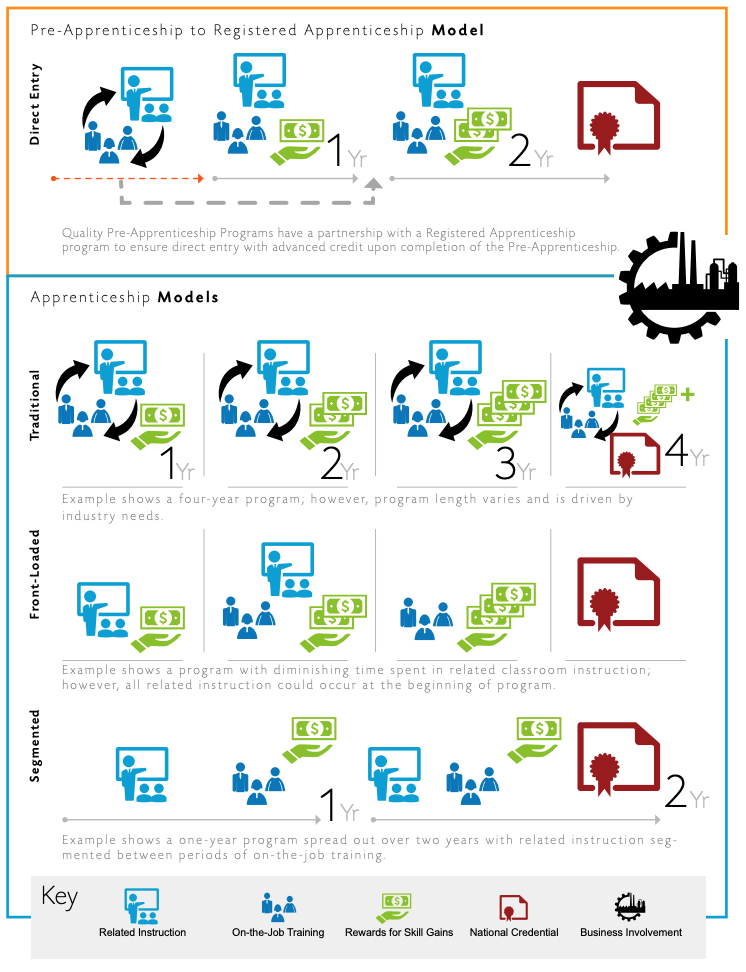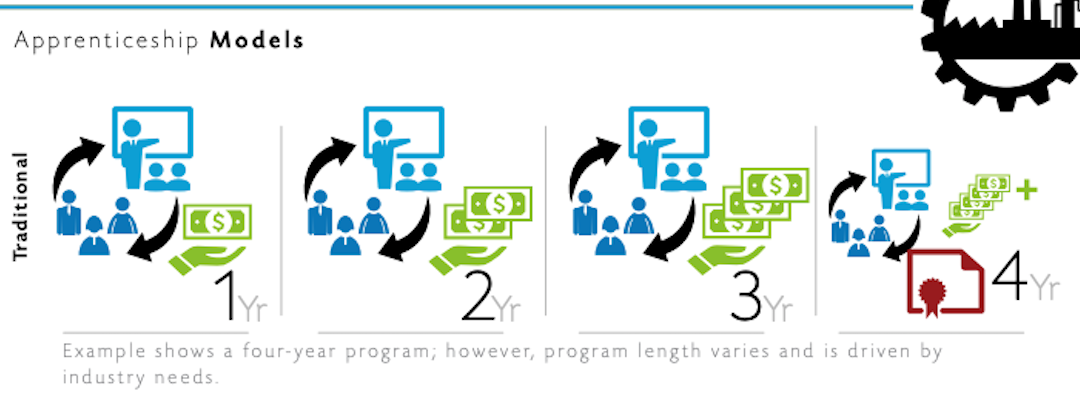One component of apprenticeship programs is Related Training Instruction (RTI). RTI refers to the classroom and/or lab learning experiences of apprentices. Hours spent in the classroom are designed to complement the On-the-Job Training (OJT) component of apprenticeships and enhance the learning experience.
Sponsors of both Registered Apprenticeship Programs (RAPs) and Industry-Recognized Apprenticeship Programs (IRAPs) have several options to satisfy the Related Training Instruction component. Furthermore, the customizability of the training allows sponsors to steer their apprentices toward maximum efficiency and productivity, selecting classes and curriculum that are specific to the employers’ needs.
Minimum Requirements of Related Training Instruction
Related Training Instruction “delivers the technical, workforce, and academic competencies that apply to the job,” according to an Apprenticeship Toolkit on the U.S. Department of Labor’s website.
Most RAPs adhere to the federal recommendation of requiring at least 144 hours of training each year. This averages to less than three hours a week over the course of the 52 weeks in a year.
IRAPs determine their own minimum requirements based on industry standards; these vary from program to program.
Apprentices complete a sequence of classes to fulfill the minimum requirements. In some cases, they might earn college credit or even a degree in addition to working toward their nationally-recognized credential. However, this is not always necessary or required by the DOL.
Related Training Instruction Providers
RAPs and IRAPs can choose to conduct in-house training or partner with an outside institution. Both scenarios enjoy certain benefits.
First, the in-house learning model works well for apprenticeship program sponsors that have instructors on staff as well as a classroom space. One advantage of an in-house experience is that sponsors can design curriculum to support their specific workforce needs. Additionally, apprentices do not have to commute for their education.
If in-house is not an option, sponsors turn to outside institutions for related training. Community colleges, technical schools, online learning platforms, or apprenticeship training schools are examples of third-party providers. Depending on the partnership, apprentices will travel to the school for class, take the class online, or an instructor will come to the employer’s location to teach.
One benefit of forming partnerships with educational institutions is that the sponsor does not have to build curriculum from scratch; rather, “education partners collaborate with the business to develop the curriculum based on the skills and knowledge needed by apprentices,” according to the Toolkit. Partnerships also might leverage more funding opportunities to cover related training instruction costs.
Finally, a hybrid of in-house and outside training also is a possibility.
A couple of other notes about education providers:
- Instructors do not need special certification. That is, unless the apprenticeship sponsor is sponsoring for an outside party.
- Upon applying for RAP or IRAP status with the DOL, aspiring sponsors only need to provide a list of topics that would be addressed in the classroom setting. This offers sponsors flexibility in selecting educational providers or even switching providers.
- The Department of Labor’s Partner Finder is one way to locate third-party training providers. RADD Training also enjoys many relationships and can help sponsors make new connections.
Models for Related Training Instruction
RAP and IRAP sponsors should choose a model for related training instruction that works best for their apprentices, the job, and the organization.
Here are three types of models, according to the Toolkit:
- A traditional model – apprentices complete both related training instruction and on-the-job training at the same time throughout the program
- A “front-loaded” model – apprentices complete some related training instruction before they begin any on-the-job training
- A “segmented” model – apprentices alternate between related instruction and on-the-job training

RTI Factors Affecting Apprentices
Sponsors have a few decisions to make when it comes to their apprentices’ related training instruction. Here are a few questions to consider:
- Should apprentices be paid for their time in the classroom? Although this is not a requirement, some sponsors pay apprentices their hourly rate to encourage consistent participation. Other sponsors provide at least a stipend to help cover travel costs for attending class at an outside provider.
- What does a related training schedule look like? The DOL does not set requirements for when RTI must take place. Rather, they want to allow for flexibility based on the needs of the business. As an example, apprentices might be in class two or three days a week for three- or four-hour sessions. Also, class might occur in the afternoon as part of the work day or in the evenings after an apprentice’s shift.
- What are your apprentices’ needs? Get to know your potential employees. Do they have families? What is their age range? Do they speak English? Do they have transportation? Access to technology? All of this comes into play when sponsors are building the most effective RTI experience for their apprentices.
Related Training Instruction Funding Assistance
Many state and federal funding opportunities are available to offset the cost of related training instruction. The Workforce Innovation and Opportunity Act (WIOA) supports apprenticeship programs’ core components, including RTI. Contact Workforce Development Boards, American Job Centers, or RADD Training for more information about WIOA. Organizations like IMEC, Lakeview Consulting, and ENJEN Connects can help you find other resources to offset any additional costs of training for apprenticeship programs.
Certain apprentices, such as veterans, might qualify for additional funding depending on their life circumstances.
RADD Training can help, too. Contact us at rdaurio@raddtraining.com.


Recent Comments